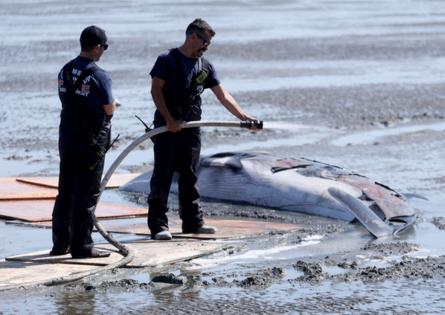Why did four whales wash up in San Francisco Bay in a week and a half?
Published in Science & Technology News
SAN JOSE, Calif. — The juvenile minke whale had been spotted swimming around San Francisco Bay for nearly a week by the time she beached herself off the coast of Emeryville April 8. Scientists had thought she seemed healthy, but after an examination, they determined she was acting abnormally and had to be euthanized due to illness.
It was the fourth whale death in the San Francisco Bay in a week and a half. The other three were gray whales, the first of which — a 36-foot-long female — washed up at Black Sands Beach in the Marin Headlands March 30. Its cause of death remains unknown.
On April 2, a deceased adult male gray whale was found floating east of Angel Island; its cause of death is also not known, according to the Marine Mammal Center. Then, a subadult male gray whale washed ashore at Fort Point Rock Beach near the Golden Gate Bridge in San Francisco April 4, and scientists determined that it likely died due to a vessel strike, according to the mammal center.
Taken together, the deaths have raised the specter of past “unusual mortality events” that caused whales to die in higher-than-normal numbers.
“This is unusual,” said Kathi George, director of Cetacean Conservation Biology at the Marine Mammal Center in Sausalito. “It takes me back to several years ago when we did have a large number of strandings happen at the same time.”
While the unusually high number of whales beaching in such a short span is abnormal, the number of whales who have died around the bay for the year has remained in line with typical levels, scientists say.
“This is the normal time of year when gray whales are doing their northward migration from Mexico up to Alaska, so it’s not uncommon for us to have gray whales in and around San Francisco Bay in April and May each year,” said Moe Flannery, who leads the marine mammal necropsy team at the California Academy of Sciences. “Although they seem high because they’re concentrated into a short period of time, the numbers of dead and stranded are not any different than the recent previous years.”
Whales can die for “a number of reasons” – from diseases to malnutrition to vessel strikes, George said.
“It’s coincidental that everything happened in a week and a half, but there are a lot of whales out there right now, and some of their physical condition that they’re in when they arrive in the bay may make them more susceptible to human impacts if they’re not as healthy,” she said.
Scientists began observing whales entering the San Francisco Bay around 2016 as they completed their annual migration between Mexico and the sub-Arctic, George said. The whales do not feed while they are in their breeding grounds in Mexico, and expend a lot of energy mating, nursing babies and giving birth before facing a long journey back north to their feeding grounds, she added.
Because of this energy expenditure, scientists have seen the gray whales attempt to feed in new locations – including San Francisco Bay, George said. Their increased appearance in the bay could also potentially be explained as whales seeking a place to rest before continuing the migration, or a reaction to climate change, warming ocean temperatures and prey availability.
The Marine Mammal Center has tracked at least 18 individual whales swimming in the bay this year, and sightings of gray whales have been reported almost every day since mid-March, George said. The majority of the whale sightings have been reported east of Angel Island, said Giancarlo Rulli, the associate director of public relations for the Marine Mammal Center.
Between 2019 and 2023, gray whales were dying in much higher numbers due to an unusual mortality event, which was declared by the National Oceanic and Atmospheric Administration Fisheries. Gray whales lost more than 40% of their population in four years, Rulli said. During this time, there were 347 gray whale strandings in the United States, according to NOAA.
“These whales basically left the Arctic with a half tank,” Rulli said. “The food sources that they were normally accustomed to eating that were highly nutritious for this massive, 10,000-to-12,000 mile journey, had moved farther away due to climate change, and as a result, these whales were left to forage on food matter that was much less nutritious.”
Between January and April 2019, which was the first year of the unusual mortality event, 34 dead gray whales washed up on California’s coast, Flannery said. Seven have so far this year.
George said that whether the recent deaths could be the start of an unusual mortality event is “still under discussion and review,” adding that the data collected from these strandings will help scientists understand “the bigger picture of what’s happening.”
“We’re not there yet,” she said, adding that scientists have to look at their migratory range holistically.
Whales will continue to appear in the bay through mid-May as they continue their migration north, George said.
Flannery added that anyone using the water “needs to be more aware of the animals that are sharing that environment.”
©2025 MediaNews Group, Inc. Visit at mercurynews.com. Distributed by Tribune Content Agency, LLC.







Comments